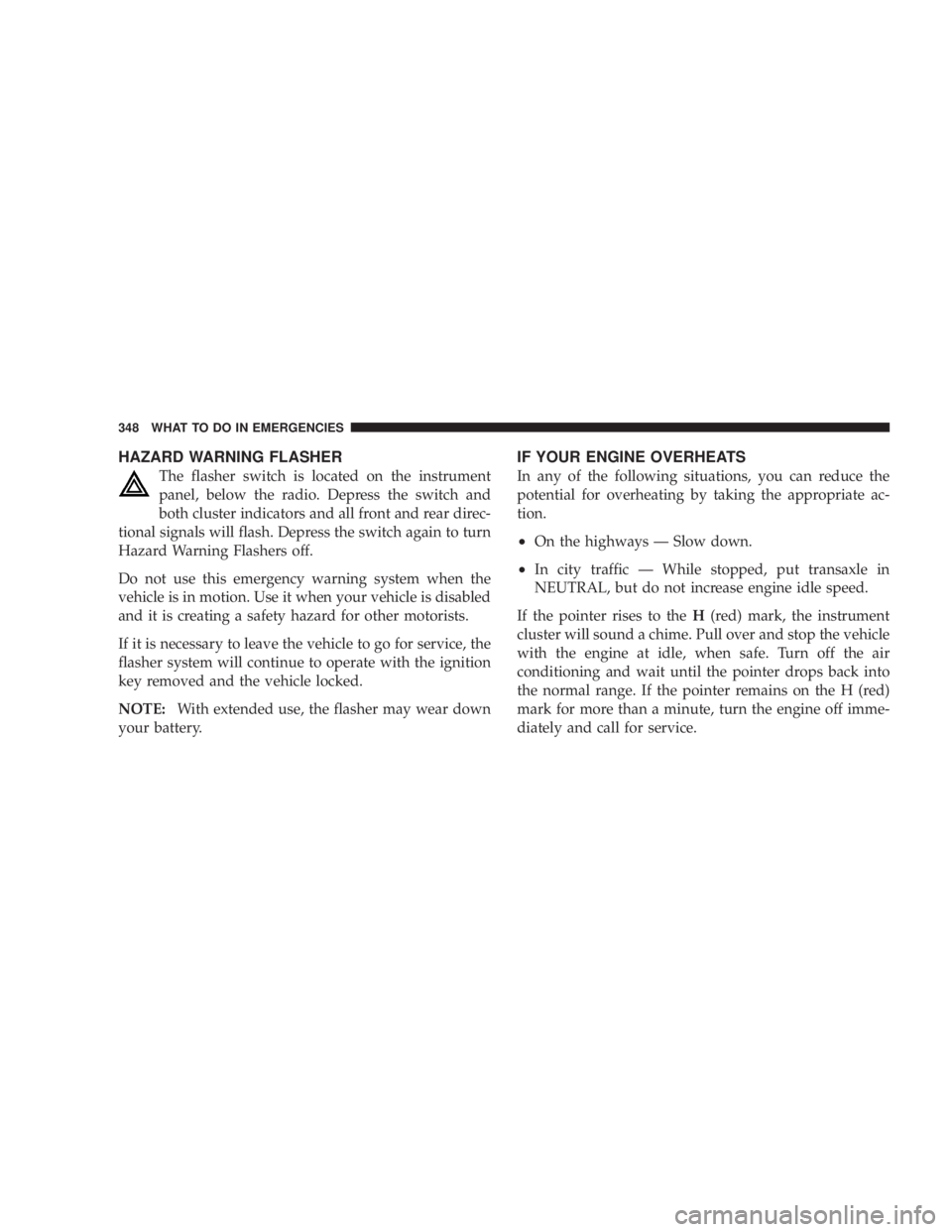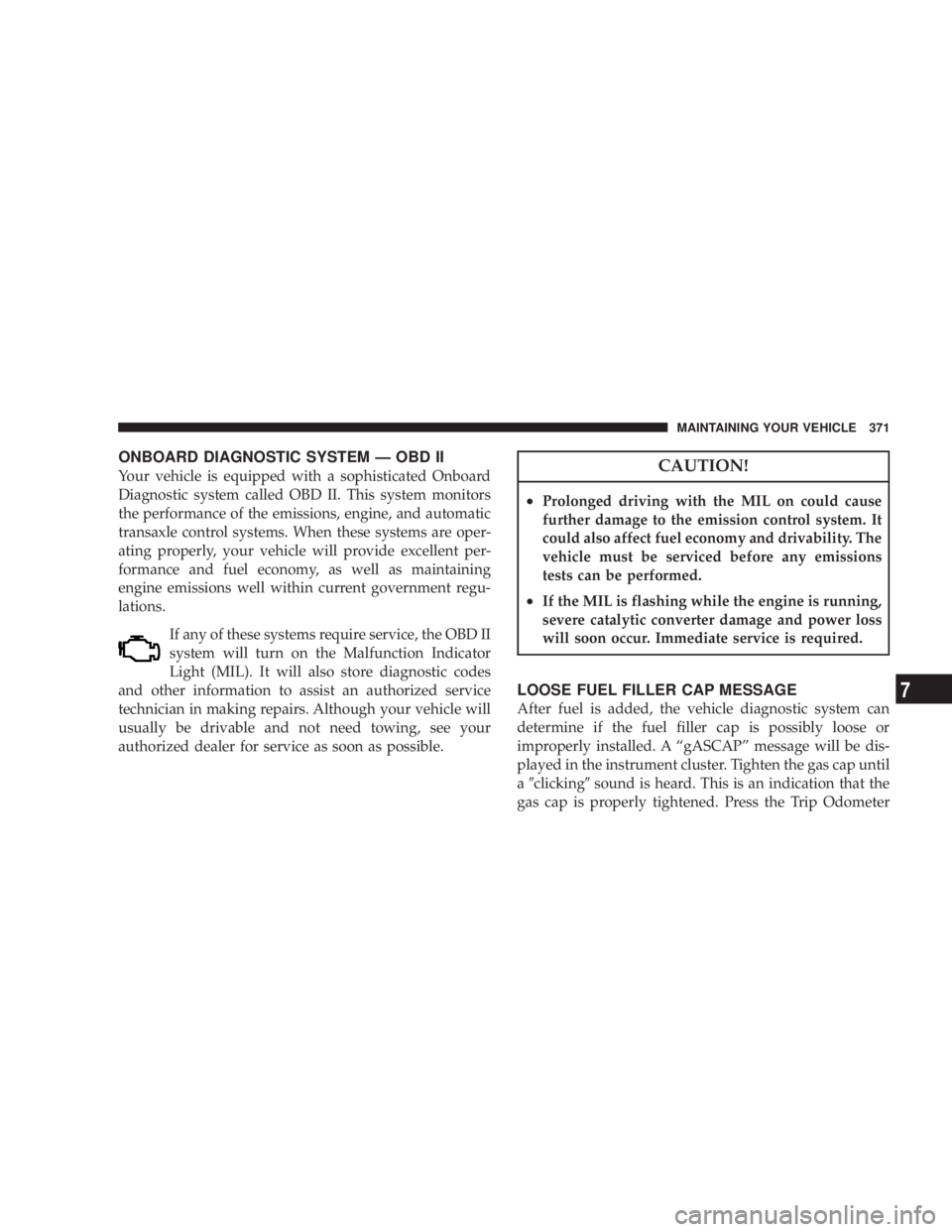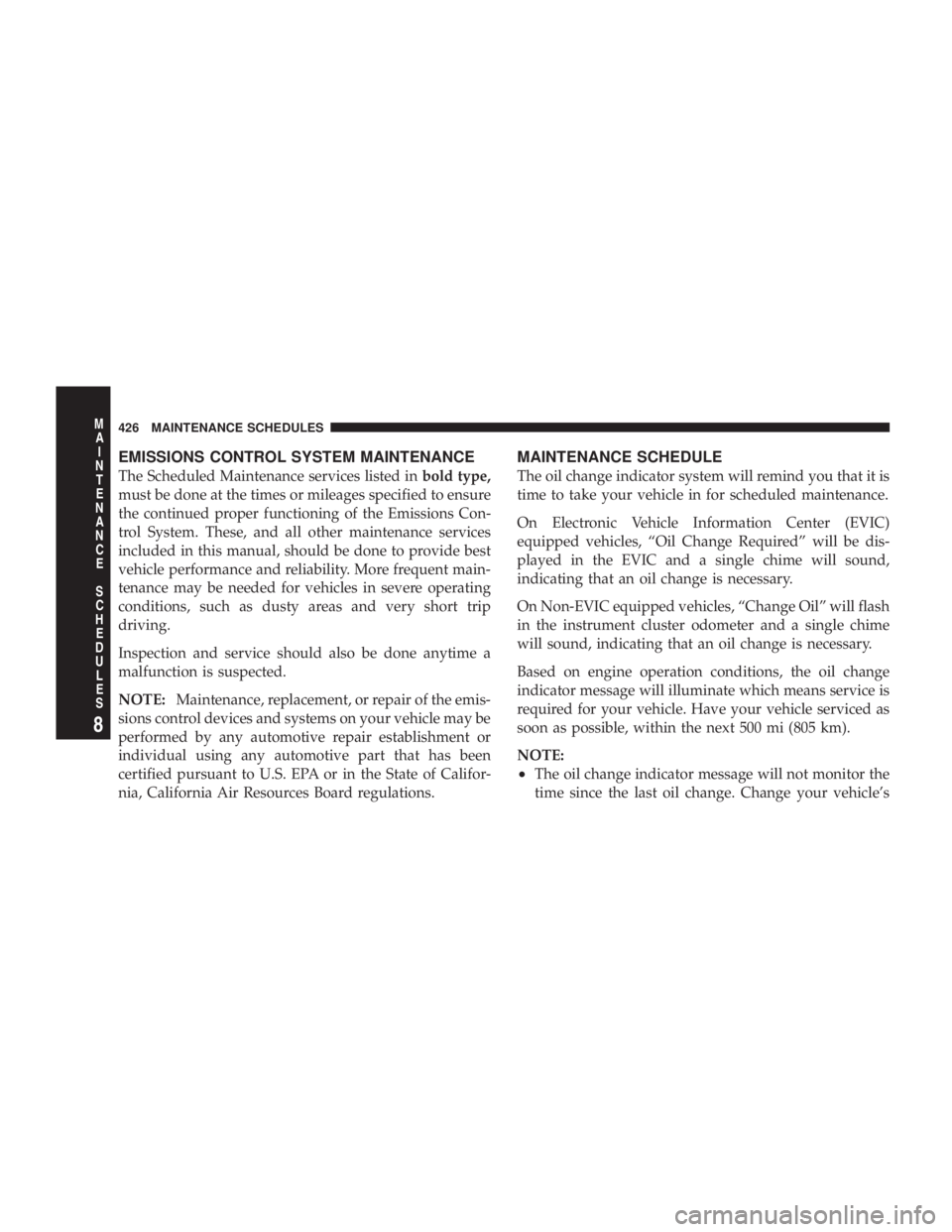2008 DODGE AVENGER service indicator
[x] Cancel search: service indicatorPage 350 of 467

HAZARD WARNING FLASHER
The flasher switch is located on the instrument
panel, below the radio. Depress the switch and
both cluster indicators and all front and rear direc-
tional signals will flash. Depress the switch again to turn
Hazard Warning Flashers off.
Do not use this emergency warning system when the
vehicle is in motion. Use it when your vehicle is disabled
and it is creating a safety hazard for other motorists.
If it is necessary to leave the vehicle to go for service, the
flasher system will continue to operate with the ignition
key removed and the vehicle locked.
NOTE: With extended use, the flasher may wear down
your battery. IF YOUR ENGINE OVERHEATS
In any of the following situations, you can reduce the
potential for overheating by taking the appropriate ac-
tion.
² On the highways Ð Slow down.
² In city traffic Ð While stopped, put transaxle in
NEUTRAL, but do not increase engine idle speed.
If the pointer rises to the H (red) mark, the instrument
cluster will sound a chime. Pull over and stop the vehicle
with the engine at idle, when safe. Turn off the air
conditioning and wait until the pointer drops back into
the normal range. If the pointer remains on the H (red)
mark for more than a minute, turn the engine off imme-
diately and call for service.348 WHAT TO DO IN EMERGENCIES
Page 373 of 467

ONBOARD DIAGNOSTIC SYSTEM Ð OBD II
Your vehicle is equipped with a sophisticated Onboard
Diagnostic system called OBD II. This system monitors
the performance of the emissions, engine, and automatic
transaxle control systems. When these systems are oper-
ating properly, your vehicle will provide excellent per-
formance and fuel economy, as well as maintaining
engine emissions well within current government regu-
lations.
If any of these systems require service, the OBD II
system will turn on the Malfunction Indicator
Light (MIL). It will also store diagnostic codes
and other information to assist an authorized service
technician in making repairs. Although your vehicle will
usually be drivable and not need towing, see your
authorized dealer for service as soon as possible. CAUTION!² Prolonged driving with the MIL on could cause
further damage to the emission control system. It
could also affect fuel economy and drivability. The
vehicle must be serviced before any emissions
tests can be performed.
² If the MIL is flashing while the engine is running,
severe catalytic converter damage and power loss
will soon occur. Immediate service is required.
LOOSE FUEL FILLER CAP MESSAGE
After fuel is added, the vehicle diagnostic system can
determine if the fuel filler cap is possibly loose or
improperly installed. A ªgASCAPº message will be dis-
played in the instrument cluster. Tighten the gas cap until
a 9 clicking 9 sound is heard. This is an indication that the
gas cap is properly tightened. Press the Trip Odometer MAINTAINING YOUR VEHICLE 371
7
Page 374 of 467

RESET button to turn off the message. If the problem
persists, the message will appear the next time the
vehicle is started. This might indicate a damaged cap. If
the problem is detected twice in a row, the system will
turn on the MIL. Resolving the problem will turn the MIL
light off.
EMISSIONS INSPECTION AND MAINTENANCE
PROGRAMS
In some localities, it may be a legal requirement to pass
an inspection of this vehicle's emissions control system.
Failure to pass could prevent vehicle registration.
For states that require an Inspection and Mainte-
nance (I/M), this check verifies the Malfunction
Indicator Light (MIL) is functioning and is not on
when the engine is running, and that the OBD II system
is ready for testing. Normally, the OBD II system will be ready. The OBD II
system may not be ready if the vehicle was recently
serviced, recently had a dead battery, or a battery replace-
ment. If the OBD II system should be determined not
ready for the I/M test, the vehicle may fail the test.
This vehicle has a simple ignition key-actuated test,
which you can use prior to going to the test station. To
check if this vehicle's OBD II system is ready, you must
do the following:
1. Insert the ignition key into the ignition switch.
2. Turn the ignition to the ON position, but do not crank
or start the engine.
3. If you crank or start the engine, you will have to start
this test over.
4. As soon as you turn the ignition key to the ON
position, you will see the MIL symbol come on as part of
a normal bulb check.372 MAINTAINING YOUR VEHICLE
Page 428 of 467

EMISSIONS CONTROL SYSTEM MAINTENANCE
The Scheduled Maintenance services listed in bold type,
must be done at the times or mileages specified to ensure
the continued proper functioning of the Emissions Con-
trol System. These, and all other maintenance services
included in this manual, should be done to provide best
vehicle performance and reliability. More frequent main-
tenance may be needed for vehicles in severe operating
conditions, such as dusty areas and very short trip
driving.
Inspection and service should also be done anytime a
malfunction is suspected.
NOTE: Maintenance, replacement, or repair of the emis-
sions control devices and systems on your vehicle may be
performed by any automotive repair establishment or
individual using any automotive part that has been
certified pursuant to U.S. EPA or in the State of Califor-
nia, California Air Resources Board regulations. MAINTENANCE SCHEDULE
The oil change indicator system will remind you that it is
time to take your vehicle in for scheduled maintenance.
On Electronic Vehicle Information Center (EVIC)
equipped vehicles, ªOil Change Requiredº will be dis-
played in the EVIC and a single chime will sound,
indicating that an oil change is necessary.
On Non-EVIC equipped vehicles, ªChange Oilº will flash
in the instrument cluster odometer and a single chime
will sound, indicating that an oil change is necessary.
Based on engine operation conditions, the oil change
indicator message will illuminate which means service is
required for your vehicle. Have your vehicle serviced as
soon as possible, within the next 500 mi (805 km).
NOTE:
² The oil change indicator message will not monitor the
time since the last oil change. Change your vehicle's426 MAINTENANCE SCHEDULES
8 M
A
I
N
T
E
N
A
N
C
E
S
C
H
E
D
U
L
E
S
Page 456 of 467

Security Alarm (Theft Alarm) .............. 18
Theft Alarm (Security Alarm) .............. 171
Tire Pressure Monitoring (TPMS) ........... 310
Traction Control ....................... 284
Turn Signal .................. 130,133,176,416
Voltage ............................. 171
Warning (Instrument Cluster Description) ..... 170
Loading Vehicle ...................... 331,333
Capacities ........................... 333
Tires ............................... 295
Locks
Auto Unlock .......................... 32
Child Protection ........................ 34
Door ................................ 30
Power Door ........................... 32
Low Tire Pressure System .................. 310
Lower Anchors and Tether for CHildren (LATCH) .. 73
Lubrication, Body ....................... 386
Lumbar Support ........................ 122 Maintenance Free Battery .................. 381
Maintenance, General ..................... 374
Maintenance Procedures ................... 374
Maintenance Schedule .................... 426
Malfunction Indicator Light (Check Engine) . . 178,372
Manual, Service ......................... 440
Map/Reading Lights ..................... 129
Master Cylinder (Brakes) .................. 396
Methanol ............................. 321
Mini-Trip Computer ...................... 184
Mirrors ................................ 85
Automatic Dimming ..................... 86
Electric Powered ....................... 86
Outside .............................. 87
Rearview ............................. 85
Vanity ............................... 88
Modifications/Alterations, Vehicle ............. 7
Monitor, Tire Pressure System ............... 310
Mopar Parts ......................... 373,439454 INDEX
Page 463 of 467

Recreational ....................... 345,363
Weight .............................. 337
Towing Assistance ....................... 102
Traction .............................. 288
Trailer Towing .......................... 334
Cooling System Tips .................... 344
Hitches ............................. 336
Minimum Requirements ................. 339
Trailer and Tongue Weight ................ 338
Wiring .............................. 342
Trailer Towing Guide ..................... 337
Trailer Weight .......................... 337
Transaxle ............................. 267
Additives ............................ 399
Automatic .................... 12,261,267,397
Autostick ............................ 274
Filter ............................... 399
Maintenance .......................... 397
Operation ........................... 267 Overdrive ......................... 271,272
Selection of Lubricant ................... 424
Transmission
Range Indicator ....................... 172
Transmitter Battery Service
(Remote Keyless Entry) .................... 26
Transmitter, Garage Door Opener (HomeLink t ) . . 143
Transmitter Programming
(Remote Keyless Entry) .................... 26
Transporting Pets ........................ 77
Tread Wear Indicators .................... 306
Trip Odometer .......................... 172
Trip Odometer Reset Button ................ 174
Trunk Release, Emergency ................ 39,40
Trunk Release Remote Control ............... 39
Turn Signals ...................... 133,176,416
UCI Connector ......................... 227
UConnectŸ (Hands-Free Phone) ........... 89,223 INDEX 461
10